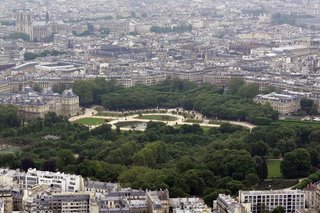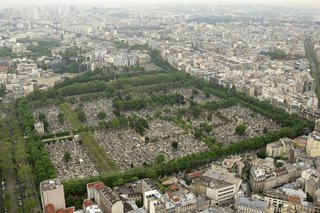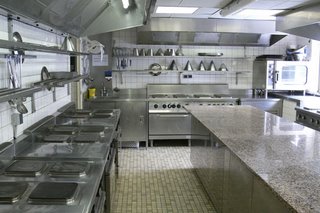
Monday we slept late. Our appointment at Le Cordon Bleu was at 3:00 pm so we thought we would just relax and spend our time exploring our neighborhood in the 15th arrondissement as well as nearby. (Paris is divided into 20 arrondissements or districts.)(photo: Luxembourg Gardens from the top of the tour Montparnasse.)
When we awoke it was a bit overcast but that soon burned off and the sun eventually peeked through off and on throughout the day. Since we had been underwhelmed by the breakfast at the hotel, we struck out on our own to find a nice café or bar to have a morning dolce and coffee. As I reported earlier the bar situation is handled a bit different than in Italy so we walked across the street to the boulangerie. Grabbed a couple of croissant armandes (with almonds) and ate them as we walked to a nearby café to get coffee. I must that so far we prefer the coffee we get in bars in Italy. Although the French use Italian machines and Italian coffee it is an odd phenomenon that the coffee in Italy tastes richer whereas the coffee in Paris seemed just, well, stronger, more bitter.
After coffee we stopped a supermarche on rue de Vaugirard and picked up some fresh fruit and a six-pack of bottled water and dropped them off back at the hotel. From there we walked over to the nearby Gare Montparnasse, one of Paris’ major train stations as well as metro hubs. It is, as the Rough Guide notes, a hodgepodge of concrete and glass on several somewhat confusing levels. At the lowest level you can the high-speed “travelator” (that’s what the Rough Guide calls these things; we know them as a moving walkway), connecting passengers between metro lines 4 and 12 and which moves at about 9 kph, or roughly three times the normal speed of a travelator. We actually rode it and it does clip along but rally didn’t seem all that dangerous.
We walked out of the Gare Montparnasse and found ourselves at the base of the Tour Montparnasse.
This “skyscraper” is certainly one of the most boring structures in Paris – or probably anywhere else for that matter – but the great thing is the view from the top. A high-speed express elevator takes you right to the 56th floor where there is a comfortable lounge, lots of really great old photos of Paris with excellent signage, cool interactive displays of the surrounding panoramas, a really handy little video presentation which is constantly running and of course stunning views which can be enjoyed while sipping a glass of wine. You can also walk up several flights of stairs to the roof for a truly spectacular view of the city. And unlike the Eiffel there are no lines, it costs less money and the view is better: it’s got the Eiffel in it of course! (Daily, 9:30am-11:30pm, admission.)

After we left the tour we strolled up rue Edgar Quinet to Montparnasse cemetery, one of three cemeteries we were to stop at during our stay in Paris.

Stopping at the entrance we picked up a handy cemetery guide which lists the famous and near-famous buried here and how to find them (or their resting place at least).
Here you can find the poet Beaudelaire, the writer Simone de Beauvoir and her lover, the philosopher Jean Paul Sartre, the political martyr Albert Dreyfus (although we couldn’t find him), the photographer and painter Man Ray, the inventor Charles Pigeon (reading to his wife in bed), the historian Edgar Quinet (after whom the nearby rue Edgar Quinet is named), the flutist Jean Pierre Rampal and the composer Saint Saens.(photo: Charles Pigeon and his wife.)

Some of the streets were lined with flowering trees and were absolutely stunning as we walked through the cemetery and of course there were plenty of fresh flowers on many a grave.

One of the interesting things about French cemeteries is the similarity between the ones would see in Paris and the cemeteries in New Orleans, Louisiana – although in fact many of the remains here are below ground, it is the presence of the sometimes very tiny chapel-like structure built directly over a single grave which makes for a very dramatic image. Some of these little “chapelettes” appeared neglected, abandoned with their doors ajar or missing, and peaking inside you can see the final vestiges of a life or an entire family, decaying, broken, shattered glass, rusted metal, everything quietly decaying away. Others are surrounded by fresh flowers or blooming shrubs recently watered, carefully maintained resting places, perhaps freshly painted, metal shining, a clear indication that not only does the family still live but that it remembers too. (photo: from Montmartre cemetery.)
After our grand stroll through the cemetery we returned to our hotel room to pick up Susan’s paperwork, mainly her application for the Diplome de Patisserie program, which we will drop off at the end our meeting with one of the school advisors.

Le Cordon Bleu was only a 10-minute walk down rue de Vaugirard, actually off on a quiet side street, and we arrived a few minutes early for our meeting with Sonia Castro from the admission office. After a few minutes waiting in the student lounge area Sonia popped in. She gave us an introduction to the school, talked about Susan’s situation and the program she was interested in, answered several questions and then the three of us were off to tour the school.

The school is small but well-designed and efficiently laid out or so it seemed to us. Each of the several floors has a demonstration room which is rather like an anatomy classroom with sloping floors leading up to the student desks, flanked by widescreen TVs on either side and at the front where the cooking demonstrations are performed a mirror on the ceiling so that students can also watch just like in a TV studio. The students follow each 3-hour demonstration with their recipes in hand, taking notes, followed by everyone moving to the practical rooms, the cooking areas in other words, where they try out the recently demonstrated recipe. We thought it seemed like a well-structured and well-thought-out approach to learning how to cook (or rather bake in this case).

After our tour we met with school advisor Christel Hernandez. We talked a bit more about the program and asked a few more questions. Susan submitted her application and we were informed that a decision would be made by the end of the week. Susan would receive an email informing her of the school’s decision. If accepted she would receive an admission proposal which would have to be signed, and returned to the school with payment. Now all we have to do is wait. And enjoy Paris. (photo: superior pastry class working with spun sugar sculptures.)
From Le Cordon Bleu we returned to the hotel, dropped off the school materials and grabbed a couple of apples and some water and headed for the metro across the street. We returned to the Montparnasse cemetery and spent some time not finding famous people but it was a nice place to stroll. We decided enough was enough and left the cemetery walking out onto rue Quinet, turning left heading back toward the metro. We found a nice little café nearby where we could sit outside, had some wine and a bite (or two) of lunch. It was quiet and we enjoyed the time thinking and talking about what the future may hold for the two of us.
After lounging for some time we paid our bill, got up and walked to the metro. We got off at the Pasteur stop and then walked down rue de Vaugirard to the hotel. We relaxed in the room for a short while but thought, hey we’re in Paris let’s go for a walk – which quickly turned into a metro ride back to Notre Dame. We strolled along the Seine down to the National Assembly and took the metro back to the hotel. By this time we were both ready for dinner and it was Lebanese food again (we simply can’t get this in Florence after all) so naturally it was back to Al Wady. After all, it was close and the food was great.
No comments:
Post a Comment